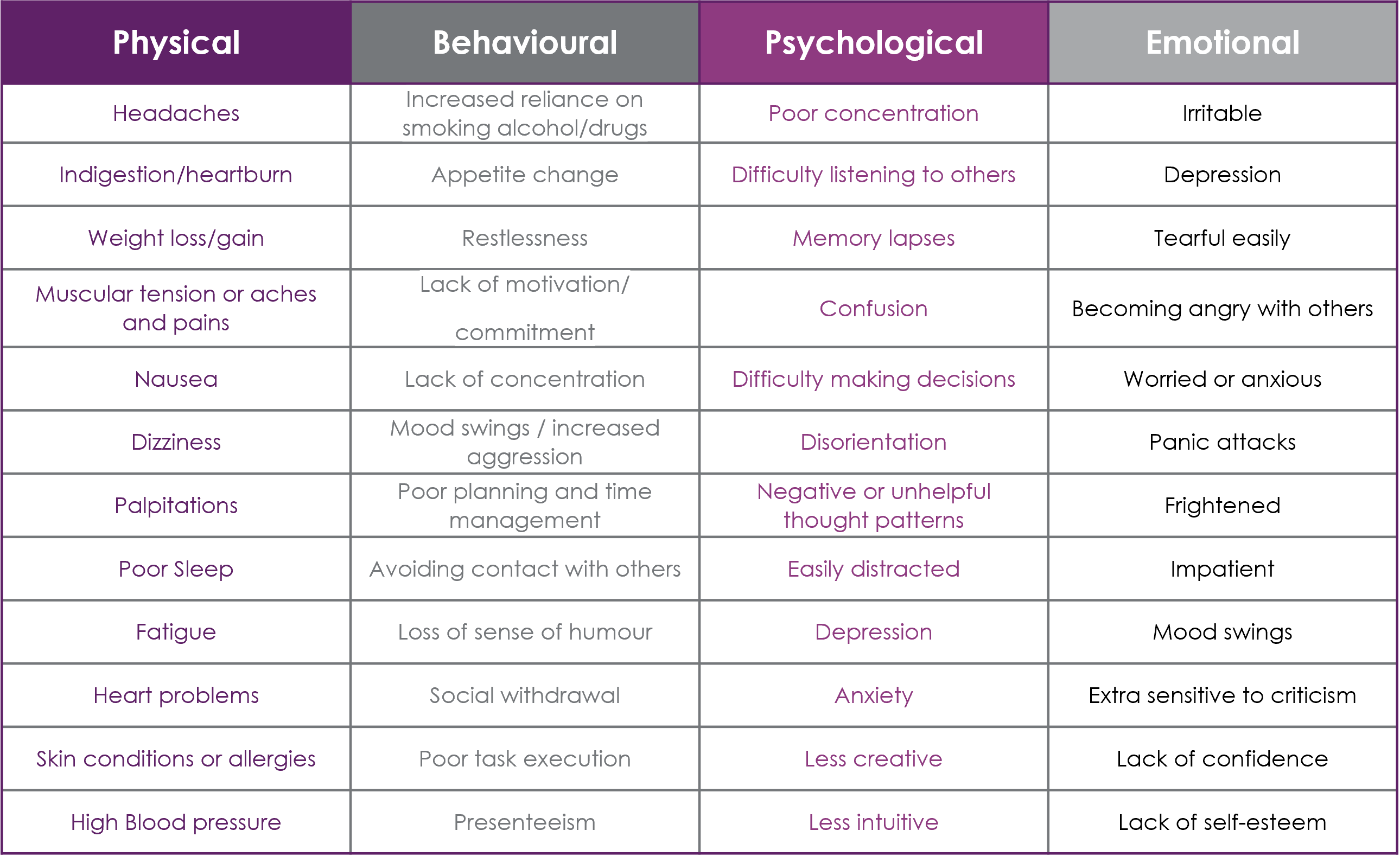According to the Health and Safety Executive (HSE), in 2022/23 875,000 workers suffered from work-related stress, depression or anxiety (new and long-standing). In connection with this, 17.1 million working days were lost in 2022/23 due to work-related stress, depression or anxiety.[i]
These figures highlight that stress in the workplace remains a major issue that must be addressed.
Let’s begin with the definition of stress. Stress is defined by the HSE as:
‘the adverse reaction people have to excessive pressures or other types of demand placed on them’.
It’s worth noting that ‘stress’ itself is not a clinically diagnosed condition, but it can produce physical symptoms and affect our mental well-being.
Stress can increase the risk of physical illnesses such as:
- Heart disease
- Back pain
- Digestive conditions like irritable bowel syndrome
- Skin conditions
And, if left unmanaged, can cause:
- ‘Burnout’ (physical and emotional exhaustion)
- Anxiety
- Depression
Stress can also make us feel ‘out of control’ and influence our mood, emotions, and the way we manage relationships.
Stress at work
Factors responsible for stress in the workplace can be linked to ‘feeling out of control’, and may include:
- Too many or conflicting demands
- Poor working conditions
- Little control over how and when work is done or decision making
- Lack of support or encouragement from managers and others at work
- Bullying and conflict at work, particularly if these are not managed well
- Not having enough training or skills to do a job
- Feeling unclear about roles and responsibilities
- Low trust and not feeling able to speak up about concerns
- Change within the organisation
Stress outside of work
External factors and life events may also contribute to work-related stress and how a person might be coping. These could include:
- Bereavement
- Divorce or separation
- Menopause
- Caring responsibilities
- Poor heath
- Financial difficulties
Noticing the signs of stress
The below table gives an indication of the possible signs of stress. Whilst we feel it is helpful to show these divided into 4 categories – physical, emotional, psychological and behavioural signs – some of the symptoms do overlap.
Stress may not be the cause, or only cause, for these symptoms, and other factors or health conditions could be triggering the symptoms. However, it’s worth being aware of these signs and their possible link to stress, especially if they are sudden or uncharacteristic changes for the individual.
Addressing stress at work
Organisations have a duty to carry out a Stress Risk Assessment to protect workers from stress in the workplace. [ii]
The HSE recommends assessing the risks of stress, and its impact on mental and physical ill-health, in the same way as you assess other work-related health and safety risks. Employers of five or more workers are required by law to record the risk assessment in writing. [iii]
You can find useful resources on ACAS and HSE websites, including a Stress Risk Assessment template, case studies and useful tools such as the Talking Toolkit from the HSE for managers on how to approach and work with employees to help identify the risks of stress.
Prevention and Stress Management
Having identified the possible risks, the next step is to review the company’s work culture and implement strategies that can help prevent or reduce these risks factors. Things to consider include:
- Encouraging open and regular conversations
- Avoiding the use of ‘stress’ in conversations: for example, ask about the ‘demands’ of an employee’s job instead
- Having a clear policy on mental health and stress
- Good employee communications – encourage people to raise their concerns without the fear of prejudices
- Providing sufficient stress-management training for managers
- Listening to employee’s concerns and taking swift action to resolve issues
- Promoting a healthy work-life balance – encouraging employees to take regular breaks and use their holiday allowance
- Discouraging ‘out of hours’ communications, to allow employees to switch off from work
The HSE’s Stress Management Standards [iv] cover six key areas of work design that, if present, demonstrate good risk assessment practices with effective stress management policies. To some extent these tie in with the risk factors mentioned above.
The Management Standards are:
- Demands – this includes issues such as workload, work patterns and the work environment
- Control – how much say the person has in the way they do their work
- Support – this includes the encouragement, sponsorship and resources provided by the organisation, line management and colleagues
- Relationships – this includes promoting positive working to avoid conflict and dealing with unacceptable behaviour
- Role – whether people understand their role within the organisation and whether the organisation ensures that they do not have conflicting roles
- Change – how organisational change (large or small) is managed and communicated in the organisation
Beyond the legal obligation, assessing the risks and managing work-related stress makes good business sense and has associated benefits. It goes without saying that people will perform better and be more productive in a company that promotes a positive working environment and looks after its people at the heart of its culture.
[i] https://www.hse.gov.uk/statistics/assets/docs/stress.pdf
[ii] https://www.hse.gov.uk/stress/risk-assessment.htm
[iii] https://www.acas.org.uk/managing-work-related-stress/understanding-the-law
[iv] https://www.hse.gov.uk/stress/standards/
Useful resources and references:
https://www.hse.gov.uk/stress/signs.htm
Work-related stress and how to manage
https://www.hse.gov.uk/stress/standards/downloads.htm
https://www.acas.org.uk/managing-work-related-stress
https://www.hse.gov.uk/stress/signs.htm
Manager’s Guide to Mental Health at Work
Mind.org mental and physical activity toolkit




